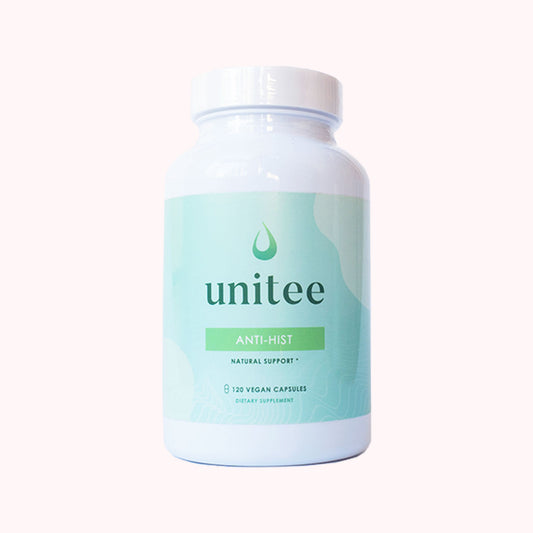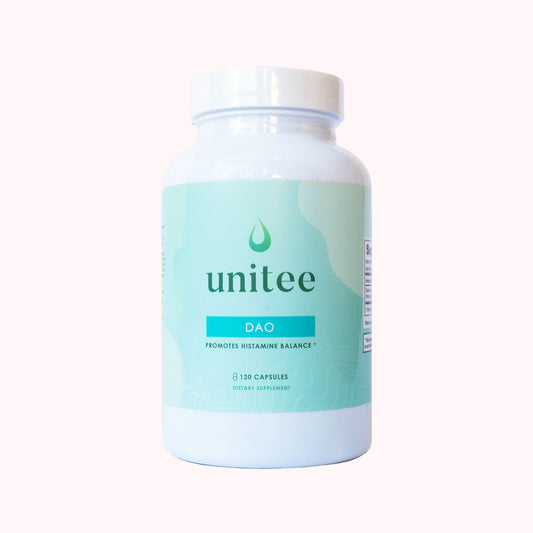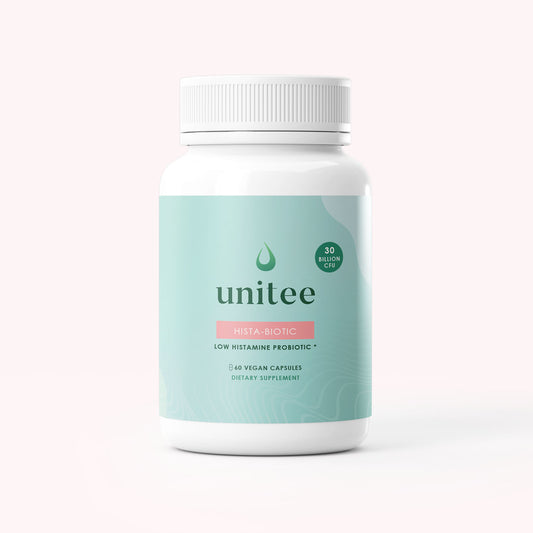When it comes to living with histamine intolerance, there are a lot of moving parts to consider. One of the first steps to overcoming histamine intolerance is to investigate the cause. Because it’s not a simple disease, before we can begin to treat the condition, we need to know why it happened in the first place!
From a previous infection to poor gut health, stress and even a genetic predisposition, getting to the bottom of your histamine intolerance may require some good detective work. It’s an essential part of trying to figure out exactly what’s gone wrong in your body that has left you with these debilitating symptoms.
Now, speaking of genetics, there’s evidence to show some people who develop histamine intolerance have problems making enough of the histamine degrading enzyme called diamine oxidase (DAO). It can stem from tiny changes in the genetic code called SNPs (snips), and the inability of the gene to give the right signal for making that enzyme.
But there are other causes of low DAO, such as nutrient deficiencies, the use of certain medications, bacteria in the gut producing too much histamine, and even eating high histamine foods that use up the body’s supplies.
And how do we know that there’s a lack of DAO in the body? Well, you’d likely want to test your level, wouldn’t you?
It may sound like the most logical approach, however, knowing what your DAO levels are may not give you the best information about your condition. Let me explain…
Inadequate Levels of Diamine Oxidase Contribute to Histamine Intolerance
As I mentioned above, diamine oxidase is one of the enzymes the body uses to break down biogenic amines, with one in particular we’re interested in, histamine. Diamine oxidase is made largely in the gastrointestinal tract, and it degrades histamine that comes into the body from the outside, like from the food you eat and drink.
DAO levels in the body are constantly changing. You may have taken a specific type of medication that may temporarily block its production, for example, certain antibiotics, heart medications, antidepressants and anti-inflammatories (1,2). You may have eaten high-histamine foods causing a lot of DAO to be used. You may have certain nutrient deficiencies such as vitamin B6, vitamin C, copper and zinc that reduce the ability of DAO to be formed (3). Or, you may have an error in one of your genes that make it difficult for the body to make adequate amounts of DAO.
Any of these, or a combination of them, can deplete your resource pool of DAO. Continue to ingest histamine-containing foods and your histamine levels will begin to rise. Too much histamine will continue to stimulate the histamine receptors throughout the body, which causes a sequence of seemingly unrelated but bothersome symptoms to begin. This is where you’ll start to notice how your tolerance to certain foods begins to change. And that’s when you develop histamine intolerance.
Now, histamine intolerance is quite hard to diagnose. The symptoms are relatively non-specific and what’s more, they can present differently in different people. It makes creating diagnostic criteria hard to standardize, and so a thorough history and clinical assessment needs to be made to confirm the condition. Some medical practitioners will also perform a diamine oxidase test to determine whether your DAO levels are inadequate.
Now, you might think this is great! A diamine oxidase test will give you more answers, and it seems logical that if your body is not making enough of it, you’re not breaking histamine down. But knowing what your diamine oxidase levels are is only a small piece of the picture! And in some cases it may leave you with more questions…
Is a Diamine Oxidase Test Accurate for Diagnosing Histamine Intolerance?
The answer is not entirely clear.
Some published research suggests that a diamine oxidase test when the outcome is low, is a good way to diagnose histamine intolerance (4). Other research contradicts this stating that because diamine oxidase levels fluctuate throughout the day, it’s not as accurate as once thought (5) and even if your DAO levels come back within normal limits, there are various additional factors to consider when confirming or excluding histamine intolerance as a diagnosis.
Let me share a scenario in which you may get a false negative reading. In other words, your diamine oxidase test comes back as normal, and you;re told you don’t have histamine intolerance. That scenario is most likely to take place in someone who has been following a strict low histamine diet. Because the exogenous, or external, histamine influx into the body is low, there may be a greater pool of DAO available and the blood levels will show as such (6).
It doesn’t mean a diamine oxidase test is always a waste. In someone who has not yet started following a low histamine diet, or in someone who has an inability to make enough DAO due to genetic reasons it may still be helpful because it’s likely that in these two instances, DAO will be low. But it might not be helpful in a large portion of the population who may have already tried decreasing their levels of histamine through diet, having had a suspicion they are histamine intolerant.
Should you indeed have a diamine oxidase test performed, the most important thing to take into account when the results come back is that it shouldn’t be a diagnostic test where the results are considered in isolation, especially if the results are negative and you react to histamine-containing foods. The results should be accompanied by a good history taking and complete clinical evaluation of the individual who is presenting with the symptoms of histamine intolerance.
Before convincing your doctor to perform a diamine oxidase test, you as the patient can also try this at-home test to determine whether dysfunction of this enzyme is contributing to the cause of your histamine intolerance.
Try This at Home Diamine Oxidase Test!
A simple way to determine whether you need more diamine oxidase is to take a DAO supplement.
If your symptoms improve while taking supplemental DAO with your meals, it’s likely that a low supply of this histamine-degrading enzyme is contributing to your symptoms. If you find that your symptoms don’t change at all while taking the supplemental DAO, it’s likely there’s more to your condition and you’ll need to focus on finding another root cause.
It’s important to note that even if your symptoms improve with supplemental DAO, you may still need to work on finding out the reason you developed histamine intolerance in the first place.
What to Do if Your Diamine Oxidase Test Comes Back Low
If your diamine oxidase test comes back showing low levels, it will likely be valuable to take a DAO supplement with every meal, up to three times per day. You’ll also want to follow a low histamine diet to further reduce your symptoms by decreasing your body’s overall histamine load, thereby decreasing the amount of DAO your body needs to use.
After following a low histamine diet and taking supplemental DAO for 12 weeks, you can begin to reintroduce a small amount of histamine-containing foods back into the diet to determine your reaction to them. If your symptoms remain in check, it’s likely your problem was high histamine load paired with inadequate DAO supply. If you experience strong reactions, you may have a genetic predisposition to low DAO production and will need to continue to take DAO with your meals.
In either case, I’d also recommend you continue to try to determine whether there are additional aspects of your condition you need to work on. You may feel good for a couple of weeks, but if you haven’t addressed your root cause, your symptoms are likely to come back.
The bottom line is that there’s no right or wrong answer when it comes to seeking out the results of a diamine oxidase test. Whatever it comes back with should be evaluated in the context of your symptoms and your personal health picture. High or low, test or no test, you can always consider taking a DAO supplement to determine the effects and level of control it provides you for managing your symptoms. Use this as an additional way to figure out the root cause of your condition, so you can put further steps in place to overcome it. For good!
References:
1. Leitner R, Zoernpfenning E, Missbichler A. Evaluation of the inhibitory effect of various drugs / active ingredients on the activity of human diamine oxidase in vitro. Clin Transl Allergy. 2014;4(Suppl 3):P23. Published 2014 Jul 18. doi:10.1186/2045-7022-4-S3-P23
2. Tobajas Y, Alemany-Fornés M, Samarra I, et al. Diamine Oxidase Interactions with Anti-Inflammatory and Anti-Migraine Medicines in the Treatment of Migraine. J Clin Med. 2023;12(23):7502. Published 2023 Dec 4. doi:10.3390/jcm12237502
3. Maintz, L., & Novak, N. (2007). Histamine and histamine intolerance. The American Journal of Clinical Nutrition, 85(5), 1185–1196.
4. Arih K, Đorđević N, Košnik M, Rijavec M. Evaluation of Serum Diamine Oxidase as a Diagnostic Test for Histamine Intolerance. Nutrients. 2023;15(19):4246. Published 2023 Oct 2. doi:10.3390/nu15194246
5. van Odijk J, Weisheit A, Arvidsson M, Miron N, Nwaru B, Ekerljung L. The Use of DAO as a Marker for Histamine Intolerance: Measurements and Determinants in a Large Random Population-Based Survey. Nutrients. 2023;15(13):2887. Published 2023 Jun 26. doi:10.3390/nu15132887
6. Rentzos, G., Weisheit, A., Ekerljung, L. et al. Measurement of diamine oxidase (DAO) during low-histamine or ordinary diet in patients with histamine intolerance. Eur J Clin Nutr 78, 726–731 (2024). https://doi.org/10.1038/s41430-024-01448-2

Anita Tee
My name is Anita Tee. I'm a nutritional scientist who specializes in histamine intolerance. I hold a Master of Science in Personalized Nutrition and a Bachelor of Science in Human Biology and Psychology.
For the past ten years, I have used my experience in nutritional and medical health sciences to create a scientifically backed, natural approach to healthcare that relies 100% on evidence-based research.
As I previously suffered from - and overcame - histamine intolerance, my focus is to increase recognition and expand the available resources and protocols available for resolving this particular disorder. To date, I have helped over 4,000 individuals fully resolve or better manage their histamine intolerance symptoms.







